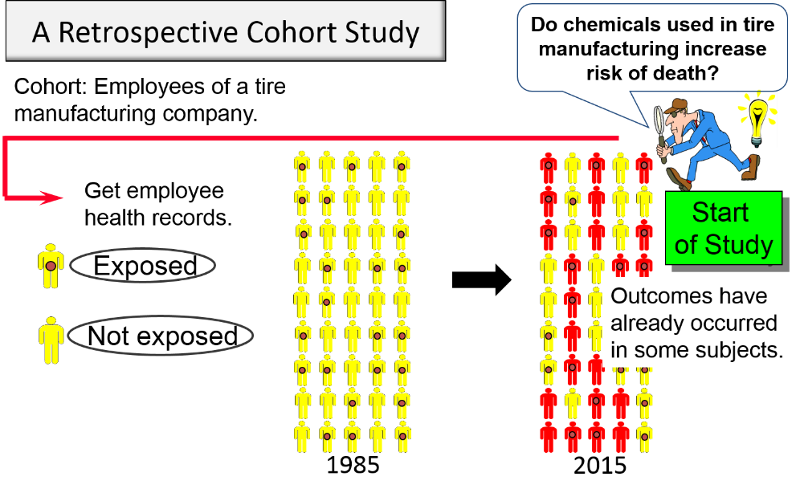Retrospective Cohort Studies
In contrast to prospective studies, retrospective studies are conceived after some people have already developed the outcomes of interest. The investigators jump back in time to identify a cohort of individuals at a point in time before they had developed the outcomes of interest, and they try to establish their exposure status at that point in time. They then determine whether the subjects subsequently developed the outcome of interest.
In essence, the investigators jump back in time to identify a useful cohort which was initially free of disease and 'at risk' of developing the outcome. They then use whatever records are available to determine each subject's exposure status at the beginning of the observation period, and they then ascertain what subsequently happened to the subjects in the two (or more) exposure groups. Retrospective cohort studies are also 'longitudinal,' because they examine health outcomes over a span of time. The distinction is that in retrospective cohort studies some or all of the cases of disease have already occurred before the investigators initiate the study. In contrast, exposure information is collected at the beginning of prospective cohort studies before any subjects have developed any of the outcomes or interest, and the 'at risk' period begins after baseline exposure data is collected and extends into the future.
Suppose investigators wanted to test the hypothesis that working with the chemicals involved in tire manufacturing increases the risk of death. Since this is a fairly rare exposure, it would be advantageous to use a special exposure cohort such as employees of a large tire manufacturing factory and conduct a retrospective cohort study.

The employees who actually worked with chemicals used in the manufacturing process would be the exposed group, while clerical workers and management might constitute the "unexposed" comparison group. Instead of following these subjects for decades, it would be more efficient to use employee health and employment records over the past two or three decades as a source of data. In essence, the investigators are jumping back in time to identify the study cohort at a point in time before the outcome of interest (death) occurred. They can classify them as "exposed" or "unexposed" based on their employment records, and they can use a number of sources to determine subsequent outcome status, such as death (e.g., using health records, next of kin, National Death Index, etc.).
Retrospective cohort studies are less expensive and more efficient than prospective cohort studies, because subjects don't need to be followed for years. However, the disadvantage is that the quality of the data is generally inferior to that of a prospective study. In the study of mortality and tire manufacturing chemicals the clerical staff may be much less exposed to the chemicals, but there are likely to be important differences in other factors that influence mortality (confounding factors), such as sex, age, socioeconomic status, education, diet, smoking, alcohol consumption, etc. Employee health records are unlikely to capture this information in sufficient detail to enable the investigators to adjust for differences in these other factors. (We will discuss adjusting for confounding later in the course.)
The distinguishing feature of a retrospective cohort study is that the investigators conceive the study and begin identifying and enrolling subjects after outcomes have already occurred in some of the subjects.

